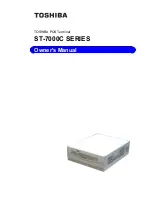
45
CHAPTER 5: Operation
5.5 Data Processing
5.5.1 P
ROCESSING OF
R
ECEIVED
M
ASTER
-P
ORT
D
ATA
The data received from the master port is always checked for commands valid
in the current data-direction mode of the unit. Valid command strings are
acted upon after all previous data received from the master port has been
processed, with the exception of the “Abort” command. If the TEP is in a
mode where the “Abort” command is valid, the TEP will act on the command
immediately (before any previously received and currently buffered data).
If the data received is not a valid command string, the data will be either
thrown away or transmitted to one or more slave ports depending on the
current data-direction mode. For example, if the TEP is in Broadcast Only or
Concentrate & Broadcast Mode, the master port’s data will be broadcast to
some or all slaves depending on the setting of the Broadcast-Mode flow-
control option (system switch SWF position 3). If the TEP is in either of the
Conversation modes, the master port’s data will be transmitted to the selected
slave device.
Optionally, data received from the master port can be echoed back to the
master device (system switch SWF position 4 on). This may be required by old
hardcopy terminals.
5.5.2 S
CANNING FOR
S
LAVE
R
ECORDS
Records from different slaves are transmitted in “round-robin” fashion.
That is, each port is checked in ascending order from Port 1 through
Port 4 (or 8). You can select when the TEP will switch from the current port
to the next sequential port by setting position 7 of system switch SWG. Refer
to
Section 5.5.4.O
.
5.5.3 P
ROCESSING
R
ECEIVED
S
LAVE
-P
ORT
D
ATA
Firstly, slave data is never checked for valid command strings. The TEP only
recognizes commands received through its master port.
Secondly, slave data doesn’t even have to be displayed or buffered. If you set
position 8 of a slave port’s DIP switch ON, the TEP will throw away that slave’s
data until you enter either Conversation mode with that slave port; only
during Conversation-mode sessions will the TEP buffer that slave’s data. This
feature is useful when the attached devices are, for example, scales that are
constantly transmitting the current weight being measured: Discarding data
outside of conversation situations assures that (a) the repeated data will not
overflow the TEP’s internal buffer and (b) you won’t have to process scale
data until you are ready to receive it.
If the option described above is not enabled for a given port, data received
from that port will be buffered in the TEP’s internal buffer at all times. Once











































